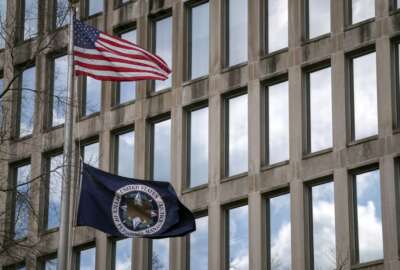OMB holding agencies ‘accountable’ for 50% in-office presence
After reaching about 80% compliance, OMB’s Jason Miller tells lawmakers he expects agencies to completely follow through with 50% in-office presence for feds.
Agencies are well on their way to reaching the Biden administration’s in-office goals for federal employees, but the Office of Management and Budget still plans to hold leaders accountable until they reach full compliance.
Based on conversations with federal leaders, agencies are roughly 80% of the way toward hitting the administration’s target for at least half of feds’ work hours being spent in the office, OMB Deputy Director for Management Jason Miller told House lawmakers Tuesday.
“We’ve been clear that our expectation is agencies are achieving at least 50%, while giving them flexibility for how to deliver,” Miller said during a House Oversight and Accountability Committee hearing. “We’ll hold them accountable for that.”
That 80% figure comes about a year after OMB first directed agencies to increase in-office presence. An April 2023 memo intended to strike a balance between in-office work and telework, while giving agencies leeway to determine what that would look like in practice. But several committee Republicans appear to be growing impatient with what they view as too long of a timeline for returning federal employees to the office — and what they said is a lack of workforce data from OMB.
In particular, some committee members during Tuesday’s hearing questioned Miller on why White House Chief of Staff Jeff Zients’ pressure on agency leaders for in-office presence took place several years after the height of the COVID-19 pandemic.
“It seems to me like COVID is ancient history right now,” Rep. Glenn Grothman (R-Wis.) said during the Oversight committee hearing Tuesday. “That email [from Zients], dated January 2024 — kind of recent — does it imply that things are going slower than your expectations?”
Echoing the stance that Zients has taken with agency heads, Miller said OMB expects agencies to completely follow through with implementing the 50% in-office presence — though he did not provide a specific deadline for implementation.
“The purpose of that approach was to strengthen teams and organizations, make sure that we had strong culture, make sure that we had innovative teams, make sure that we’re able to bring people on board,” Miller said during the hearing. At least half of federal employees never telework, as their job duties require them to be entirely on site, Miller added.
But in reaction to OMB’s return-to-office push, many federal employees as well as their unions have argued that telework is a crucial flexibility for strong federal recruitment and retention. They have repeatedly urged agencies to use lessons learned from the pandemic as a rationale to maintain higher telework levels — and not push a 50% return-to-office.
Office space concerns
In contrast, some Republican committee members said they believed a 50% in-office presence wasn’t a high enough goal. A few pointed to a 2023 report from the Government Accountability Office, which revealed many agencies sitting at or below 25% capacity in their physical office spaces.
“For most of America, 50% would still seem like a low mark,” Rep. Michael Cloud (R-Texas) said to Miller during the hearing. “I mean, granted, that would be progress compared to 25% … [but] we don’t have agencies coming to us and saying, ‘Well, we don’t need this building anymore, or we don’t need this office space, so we can reduce our budget here to make up for it there’ — so I would just encourage you to continue to work on that.”
GAO, though, has said the challenge of handling federal office space long predates the COVID-19 pandemic. Federal property management has remained on GAO’s High Risk List since 2003. The underutilization of federal office space is a more complex issue than can’t be blamed solely on telework, GAO officials have said. In fact, by GAO’s calculations, even if an agency had 100% staff attendance, the office space it would still only be about two-thirds utilized.
The Public Buildings Reform Board has reported that agencies now have a “unique opportunity” to reinvest their budgets into more modern office amenities, if they’re able to sell or otherwise dispose of unneeded real estate.
During the hearing, Rep. Stephen Lynch (D-Mass.) encouraged OMB to follow suit of the private sector and look at ways to cut back on total office holdings by maintaining telework at least to some degree.
“The private sector sees the value in working from home, and so they’re capitalizing on that,” Lynch said. “They don’t need all this expensive space now … they’re operating more efficiently.”
Miller said the administration is heading in that direction with its efforts for agencies, but is still leaving room for adjustment later on, if needed.
“In crafting our governmentwide guidance, we have followed very closely the research and actions by the private sector,” Miller said. “Ultimately, we need to compete for talent … And right now, the research suggests that where we’re landing is the right answer. But of course, we’re going to be dynamic going forward.”
Additionally, Rep. Shontel Brown (D-Ohio) pointed to reports showing that remote work and telework help increase diversity in the federal workforce.
“The administration has a significant amount of leverage to promote changes in the workforce, making it more reflective for people of all backgrounds … for people who face all types of barriers, like access to transportation, taking care of an aging relative or having to pick up their children from school,” Brown said.
Frustrations over in-office, telework data
At the same time, several committee members voiced concerns about delays and backlogs in public-facing federal services, which Chairman James Comer (R-Ky.) said he blames on telework.
“You can see the frustration on our side of the aisle because we don’t believe the federal government is any more efficient or productive with its new, wide-open telework policy,” Comer said. “[Caseworkers] have had significant difficulty getting people on the phone at the [Department of Veterans Affairs], at the IRS, at the U.S. Department of Agriculture — the agencies go on and on … It appears that’s because they have a lot of their workforce still working from home.”
In contrast, a large majority of federal employees themselves have said telework actually improves their performance, and has positive ripple effects on agency recruitment and retention. A recent Federal News Network survey showed that about two-thirds of feds said they’re more productive while working from home.
During the hearing, Comer once again doubled down on his push to get deeper telework data from OMB and other agencies — asking OMB for details on the number of teleworking employees across government, and how telework impacts productivity. Unsatisfied with OMB’s response, Comer said he doubted that agencies have the information on hand at all.
“No one says we’re totally opposed to telework — we just want to see data that shows it’s more efficient,” Comer said. “And I don’t think you all have that data.”
The Office of Personnel Management releases an annual telework report, detailing figures on how many federal employees are teleworking at each agency. And the Federal Employee Viewpoint Survey (FEVS) offers additional data on federal telework.
But in Congress, the push for deeper data continues to intensify. OMB is nearing a congressional deadline from the fiscal 2024 appropriations package, which tells OMB to turn over all agencies’ return-to-office “action plans” by late June.
Copyright © 2025 Federal News Network. All rights reserved. This website is not intended for users located within the European Economic Area.
Drew Friedman is a workforce, pay and benefits reporter for Federal News Network.
Follow @dfriedmanWFED






